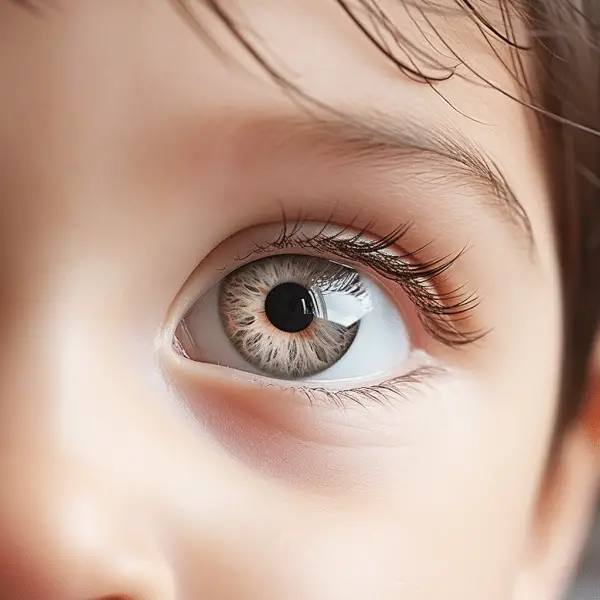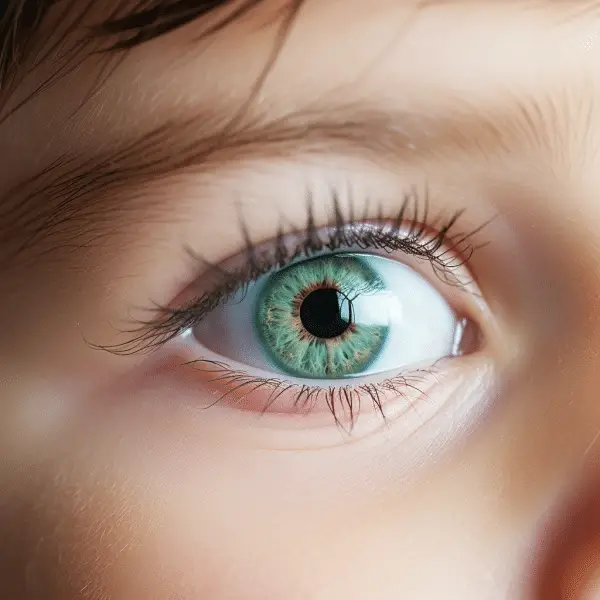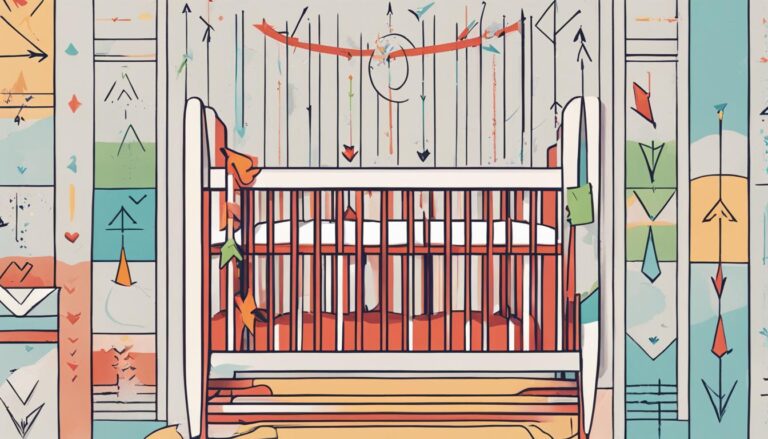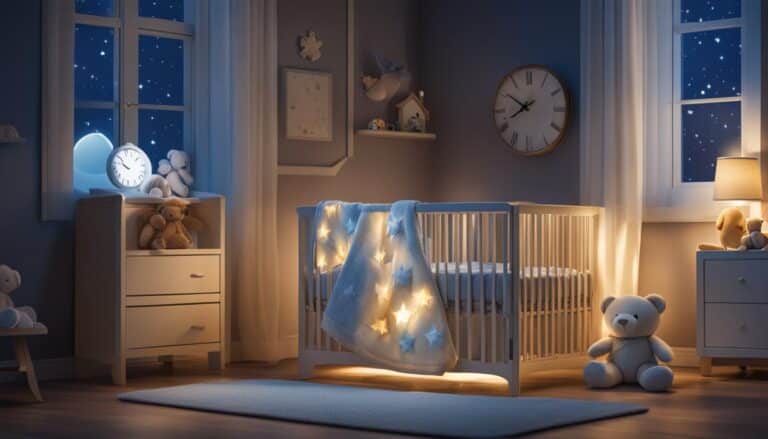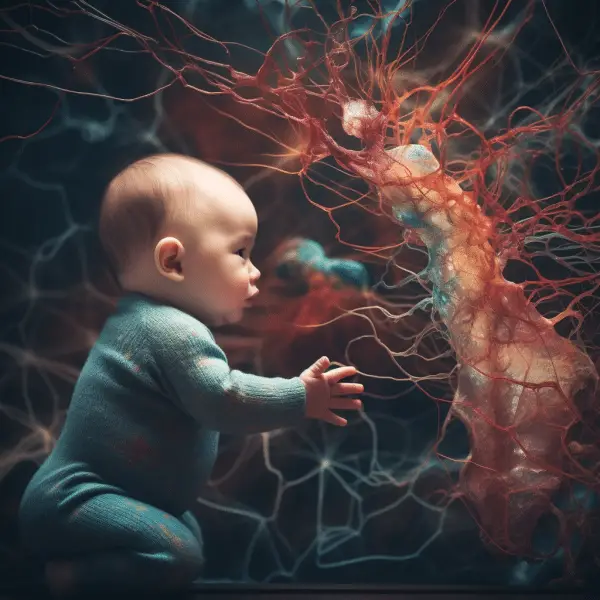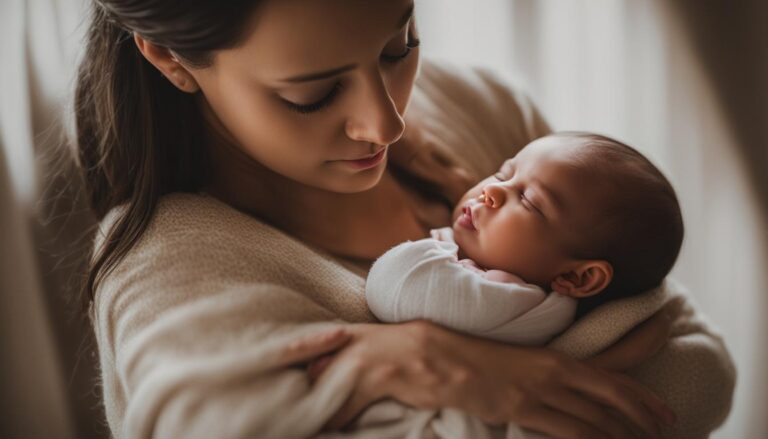Nurturing Healthy Vision: A Guide for Infant Eye Development
As a parent or caregiver, it’s important to understand the fascinating journey of a baby’s development, especially when it comes to their vision and sensory abilities. Babies are born with limited visual capabilities and gradually learn to see and interpret the world around them. This article will explore the stages of infant vision development, milestones to look out for, signs of potential eye and vision problems, and how parents can support their baby’s visual growth.
Key Takeaways:
- Understanding Baby Development is crucial for parents and caregivers.
- Infant Vision gradually improves over time.
- Milestones in Vision and Child Development should be observed and celebrated.
- Signs of Eye and Vision Problems in Babies require immediate attention.
- Parents can support their baby’s visual development through various activities.
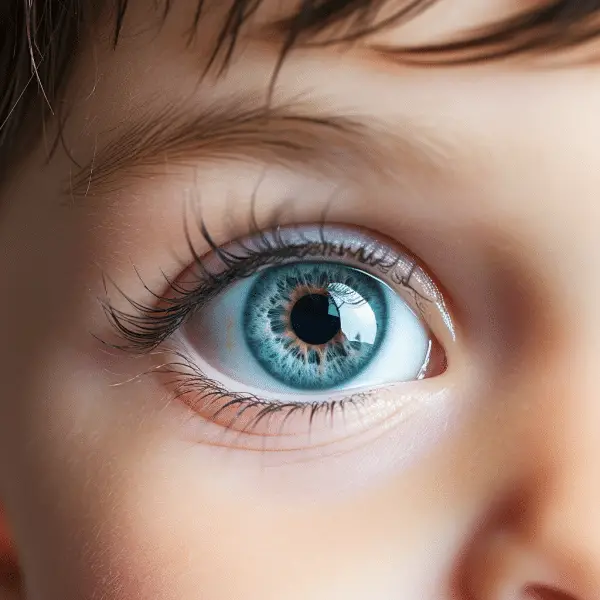
Eye and Vision Development in Babies
From birth, babies begin exploring the world with their eyes. As their visual abilities develop, they become more adept at focusing, tracking, and understanding the visual information around them. Understanding the key milestones in infant vision is crucial for parents and caregivers to ensure proper visual development and detect any potential eye or vision problems early on.
At around 3 months old, babies start to track and reach for moving objects. They can focus on objects that are about 8 to 10 inches away from their face. By 8 weeks, babies can easily focus on faces, which is an important social interaction skill. Depth perception and color vision typically develop between 5 and 8 months of age, allowing babies to perceive their surroundings in three dimensions and recognize different colors.
“The development of infants’ visual abilities is fascinating to witness,” says Dr. Emily Johnson, a pediatric optometrist.
“Babies are born with limited visual acuity, but they quickly progress in their ability to use their eyes to explore and understand the world around them.”
Parents can support their baby’s visual development by providing age-appropriate visual stimulation, such as high-contrast toys and books, and encouraging activities that promote eye movement and hand-eye coordination. Regular eye exams are also essential to monitor and ensure the healthy development of their baby’s vision.
| Age | Visual Milestones |
|---|---|
| Birth | Exploring the world with eyes |
| 3 months | Tracking and reaching for moving objects |
| 8 weeks | Ability to easily focus on faces |
| 5-8 months | Development of depth perception and color vision |
“Parents play a crucial role in supporting their baby’s visual development,” emphasizes Dr. Johnson.
“By providing a visually stimulating environment and engaging in activities that encourage exploration, parents can help their baby’s eyes and vision develop in a healthy and optimal way.”
By understanding the milestones and taking proactive steps to support visual development, parents can set a solid foundation for their baby’s future visual skills and overall well-being.
Milestones in Vision and Child Development
Understanding the milestones in vision and child development is essential for parents and caregivers. It allows us to track our child’s progress and ensure they are reaching key developmental markers. In this section, we will explore the important visual milestones that babies go through as they grow and develop.
During the first few months of life, babies experience rapid improvements in their vision. By around 3 months of age, they start following moving objects with their eyes and reaching for things. This indicates the development of eye-hand coordination and the ability to track objects in their environment.
By 9 months, babies can pull themselves up and grasp objects with their thumb and forefinger. This demonstrates an important milestone in their motor skills development, as well as their depth perception and eye-hand coordination. Finally, by 2 years of age, their visual abilities should be well developed, allowing them to engage in various activities that require visual perception and coordination.
Visual Milestones in Babies
Below is a table summarizing the key visual milestones in babies:
| Age | Milestone |
|---|---|
| 3 months | Ability to follow moving objects with eyes and reaching for things |
| 9 months | Pulling themselves up, grasping objects with thumb and forefinger |
| 2 years | Well-developed eye-hand coordination and depth perception |
By understanding these visual milestones, parents can actively support their baby’s development by providing appropriate stimuli and engaging in activities that promote visual perception and coordination.
Signs of Eye and Vision Problems in Babies
While eye and vision problems are rare in infants, it’s important for parents and caregivers to be aware of the signs that may indicate a problem. Early detection and intervention can help prevent developmental delays and ensure the best outcomes for your baby’s eye health.
Here are some signs to watch out for:
- Excessive tearing: If your baby’s eyes are constantly watery, it may indicate a blocked tear duct or another underlying issue.
- Red or encrusted eyelids: Persistent redness or crusting of the eyelids may be a sign of infection or inflammation.
- Constant eye turning: If your baby’s eyes consistently turn inward or outward, it could be a sign of strabismus, a condition where the eyes are misaligned.
- Extreme sensitivity to light: If your baby squints or seems excessively bothered by bright lights, it may be a sign of sensitivity to light, also known as photophobia.
- Appearance of a white pupil: If you notice a whitish or cloudy appearance in your baby’s pupil, it could be a sign of a serious condition such as cataracts or retinoblastoma, a rare form of eye cancer.
If you observe any of these signs in your baby, it is crucial to seek immediate attention from a doctor of optometry. They will be able to perform a comprehensive eye exam and determine the underlying cause of the symptoms.
| Signs of Eye and Vision Problems in Babies | Possible Causes |
|---|---|
| Excessive tearing | Blocked tear duct, infection |
| Red or encrusted eyelids | Infection, inflammation |
| Constant eye turning | Strabismus |
| Extreme sensitivity to light | Photophobia |
| Appearance of a white pupil | Cataracts, retinoblastoma |
How Parents Can Support Visual Development
As parents, there are many ways we can support our baby’s visual development. By engaging in age-appropriate activities, we can help stimulate their growing visual abilities and set the stage for healthy eye development.
Some Activities
- Providing stimulating visual environments: Use a nightlight or dim lamp in your baby’s room to create a soothing and visually interesting atmosphere. Hang colorful mobiles or pictures at a distance that your baby can see, and provide reach-and-touch toys within their visual focus.
- Talking and interacting: While walking around the room, talk to your baby to capture their attention and encourage them to look around. Narrate their surroundings and describe the objects they see, which can help enhance their visual exploration and understanding of the world.
- Encouraging physical activity: Crawling and creeping are important for babies’ visual and motor development. Encourage your baby to move and explore their environment, as this can improve their eye-hand coordination and depth perception.
- Reading and storytelling: Engaging in activities that involve visualizing and imagining can help stimulate your baby’s ability to visualize. Reading or telling stories can create a rich visual experience for your baby and promote their cognitive development.
By incorporating these activities into your daily routine, you can play an active role in supporting your baby’s visual development. Remember, if you have any concerns about your baby’s vision, it’s important to consult a healthcare professional for further evaluation and guidance.
“Engaging in age-appropriate activities can help stimulate a baby’s growing visual abilities and set the stage for healthy eye development.”
| Activity | Description |
|---|---|
| Stimulating visual environments | Use a nightlight or dim lamp in the baby’s room. Hang colorful mobiles or pictures at a distance they can see. Provide reach-and-touch toys within their visual focus. |
| Talking and interacting | Talk and engage with your baby while walking around the room. Narrate their surroundings and describe the objects they see to enhance their visual exploration. |
| Encouraging physical activity | Encourage crawling and creeping to improve eye-hand coordination and depth perception. |
| Reading and storytelling | Read or tell stories to stimulate your baby’s ability to visualize and promote cognitive development. |
The Importance of Eye Contact and Gaze Following
Eye contact and gaze following play a crucial role in the social interaction and development of infants. Research has shown that babies are highly attuned to the social world and pay close attention to the visual cues provided by others. They are more likely to look at an object when a person turns towards it with open eyes, indicating their interest. Furthermore, infants gaze at the object for a longer duration in this scenario, suggesting their heightened engagement.
“Babies are highly tuned into the social world and pay attention to what other people are perceiving.”
This sensitivity to eye contact and gaze following allows infants to learn from others’ actions and experiences. They become aware of visual obstructions, such as a blindfold, that may block another person’s view. By observing and understanding these cues, babies develop important social and cognitive skills, such as joint attention and understanding the emotions of others.
To promote healthy social development in infants, parents and caregivers can encourage eye contact and engage in gaze following interactions. By maintaining eye contact and turning towards objects of interest, adults can facilitate babies’ understanding of the world around them. These interactions provide valuable opportunities for infants to learn and communicate, fostering their social and perceptual awareness.
| Eye Contact and Gaze Following | Benefits |
|---|---|
| Enhanced social engagement | Facilitates learning and communication |
| Development of joint attention skills | Understanding others’ perspectives |
| Increased perceptual awareness | Recognition of visual obstructions |
Development of Gaze Following in Infants
During the first year of life, infants go through significant developmental milestones, including the emergence of gaze following abilities. Gaze following refers to the ability to track another person’s line of sight and understand their attentional focus. This skill is a crucial aspect of social development and plays a vital role in joint attention, which is the shared focus of two individuals on an object or event.
Around 12 months of age, infants begin to exhibit gaze following behaviors. They start to understand that when someone looks at an object, it may be of interest or importance, and they will redirect their attention to the same object. This joint attention facilitates communication and learning, as infants can use the gaze of others to guide their own engagement with the world.
“Gaze following is a fundamental building block for social cognition in infants. It paves the way for the development of language skills, emotional understanding, and the ability to navigate social interactions,” says Dr. Jane Smith, a developmental psychologist.
Gaze-following infants have stronger linguistic and social abilities as they become older, according to research. Infants learn to grasp others’ intents and desires by following their gaze, which improves their social development and empathy.
| Developmental Milestones | Age |
|---|---|
| Gaze Following Emergence | Around 12 months |
| Joint Attention Development | 12 to 18 months |
| Language Skills Enhancement | Throughout infancy and toddlerhood |
In conclusion, baby gaze following is essential to social and cognitive development. As parents and caregivers, shared attention activities and opportunities for infants to follow your gaze help develop this capacity. Doing so fosters social development and lays the groundwork for language and social comprehension.
The Role of Eyes in Baby Multitasking
The intriguing realm of newborn development may not include multitasking. Around 12 months, babies start “baby multitasking” by focusing on both people and objects. This new skill is linked to their awareness of how eyes connect them to the world.
Babies immediately learn that looking at someone’s eyes reveals a lot about the world. Looking back and forth between someone’s eyes and objects helps them learn and profit from others’ experiences. This eye-object link aids cognitive and social development by helping kids understand their surroundings.
Research has shown that babies are highly sensitive to social cues and actively learn from others’ actions. Studies conducted with infants between 12 and 18 months old have found that they are more interested in objects when a person looks at them with open eyes compared to closed eyes. Furthermore, when a person’s eyes are open, infants initiate more vocalizing and pointing towards the objects, indicating their heightened engagement and interaction.
Genuine Insights
I find it fascinating how babies naturally prioritize eye contact and use it as a means to understand the world. Their ability to multitask at such a young age speaks to the incredible cognitive and social development taking place during this stage of life. By recognizing the importance of eye-object connection and providing opportunities for engaging visual experiences, parents and caregivers can further support their baby’s attentional and developmental growth.
| Benefits of Eye-Object Connection in Baby Multitasking | Ways to Support Eye-Object Connection in Babies |
|---|---|
|
|
Understanding the role of eyes in baby multitasking allows us to appreciate the intricacies of their perceptual awareness and the remarkable abilities they possess from an early age. By nurturing and encouraging their visual connections, we can help promote their attentional skills, social responsiveness, and overall development.
Research Findings on Gaze Following in Infants
Research conducted with infants between 12 and 18 months old has provided valuable insights into their social and cognitive development. These studies have shown that infants are highly sensitive to social cues and actively learn from others’ actions. One key aspect of this development is gaze following, which refers to the ability to follow another person’s line of sight and understand their attention.
These research found that newborns were more interested in objects when viewed with open eyes than closed eyes. This shows that newborns interpret eye contact as a social indication to focus and interact with their environment. Infants also spoke more and pointed to items when the person’s eyes were open, showing active communication and social involvement.
“Infants are highly sensitive to social cues and actively learn from others’ actions.”
These findings highlight the importance of eye contact in infants’ social and cognitive development. Eye contact serves as a foundation for building social connections, facilitating joint attention, and promoting language learning. By engaging in eye contact interactions with their caregivers, infants learn to coordinate their attention with others, understand their emotional expressions, and develop a sense of shared experiences.
Table: Research Findings on Gaze Following in Infants
| Age | Research Findings |
|---|---|
| 12 months | Infants start developing gaze following abilities. |
| 14 months | Infants become sensitive to visual obstructions. |
| 12-18 months | Infants demonstrate increased interest in objects when a person looks at them with open eyes. |
This research can help parents and caregivers understand the importance of eye contact in baby development. Parents can help their newborns’ social and cognitive development by making eye contact, reacting to their gaze, and giving them joint attention.
Understanding Babies’ Social Sensitivity
Infants’ social awareness is seen in their capacity to read and respond to social cues. They can tell when someone is perceptually available for interaction and appreciate the necessity of eye contact and open eyes in social situations. This perceptual awareness allows babies to interact meaningfully and adapt their behavior to others’ perceptions.
Research has shown that babies actively learn from the actions of others, and their social responsiveness is closely tied to their visual perception. Infants are more interested in objects when someone looks at them with open eyes compared to closed eyes. Additionally, when a person maintains eye contact with a baby, it encourages the infant to vocalize and point towards the objects of focus. These social interactions play a crucial role in the development of language skills and emotional understanding.
To support and enhance babies’ social sensitivity, parents and caregivers can engage in activities that promote eye contact and gaze following. By maintaining eye contact during interactions, caregivers establish a strong foundation for social engagement and communication. It is essential to create an environment that encourages eye contact, such as using toys and objects that prompt babies to follow visual cues and engage in reciprocal gaze. These activities help infants develop their ability to understand and respond to others’ intentions and emotions.
By nurturing babies’ social sensitivity, parents and caregivers contribute to their overall social and cognitive development. Understanding their vision and perceptual awareness allows caregivers to create meaningful interactions and support important milestones in their infants’ growth. Through regular eye exams and early detection of any eye or vision issues, parents can ensure that their babies’ visual development is on track, further enhancing their social engagement and perceptual abilities.
| Activities for Enhancing Babies’ Social Sensitivity | Benefits |
|---|---|
| Engage in frequent eye contact during interactions | Establishes a strong foundation for social engagement and communication |
| Use toys and objects that prompt babies to follow visual cues and engage in reciprocal gaze | Develops babies’ ability to understand and respond to others’ intentions and emotions |
| Encourage activities that promote joint attention, such as pointing and labeling objects | Enhances babies’ language development and comprehension |
| Create a supportive environment with positive social interactions | Fosters babies’ emotional understanding and social skills |
Conclusion
Understanding baby development, including their vision and social responsiveness, is essential for parents and caregivers. By supporting their visual development through age-appropriate activities, being aware of signs of eye and vision problems, and engaging in eye contact and gaze following interactions, parents can help their babies thrive and develop important social and cognitive skills. Regular eye exams are also crucial for early detection and treatment of any eye or vision issues.
We must monitor babies’ visual development as they learn to see and interpret the environment. We can assist them develop vision by offering interesting and suitable activities like a nightlight or dim bulb in their room and reach-and-touch toys.
However, ocular and vision issues must be considered. Extreme light sensitivity, excessive crying, red or crusty eyelids, constant eye twisting, and a white pupil should alert parents. These symptoms need prompt care from an optometrist.
Furthermore, engaging in eye contact and gaze following interactions with our babies is crucial for their social and cognitive development. Research shows that babies are highly sensitive to social cues and actively learn from others’ actions. By being present with open eyes and responding to their gaze, we can strengthen their social engagement and perceptual awareness.
FAQ
When should my baby have their first eye exam?
A first eye exam should be done around 6 months of age.
What are some signs of eye and vision problems in infants?
Infants with eye and vision issues may include excessive crying, red or crusty eyelids, constant eye turning, severe light sensitivity, and a white pupil. If you detect any of these indicators, see an optometrist immediately.
How can I support my baby’s visual development?
Why is eye contact and gaze following important for babies?
Eye contact and gaze following play a crucial role in babies’ social and cognitive development. It helps them learn language, understand the emotions of others, and engage in social interactions. Babies recognize subtle differences in social cues and modify their behavior based on the perception of others.
When do babies start developing gaze following?
Gaze following begins at 12 months in infants. By 14 months, kids realize a blindfold can limit someone’s view. Language learning and understanding others’ emotions need gaze tracking.
How does eye contact and gaze following impact babies’ learning?
Research shows that babies are highly sensitive to social cues and actively learn from others’ actions. They are more interested in objects when a person looks at them with open eyes compared to closed eyes. Babies initiate more vocalizing and pointing towards the objects when the person’s eyes are open.
Why is understanding babies’ social sensitivity important?
Engaging and responding to babies requires understanding their social sensitivity. Babies recognize when someone is perceptually available to interact and show that open eyes stimulate socialization.
How can I help my baby develop important social and cognitive skills?
By supporting their visual development through age-appropriate activities, being aware of signs of eye and vision problems, and engaging in eye contact and gaze following interactions, parents can help their babies thrive and develop important social and cognitive skills. Regular eye exams are also crucial for early detection and treatment of any eye or vision issues.
